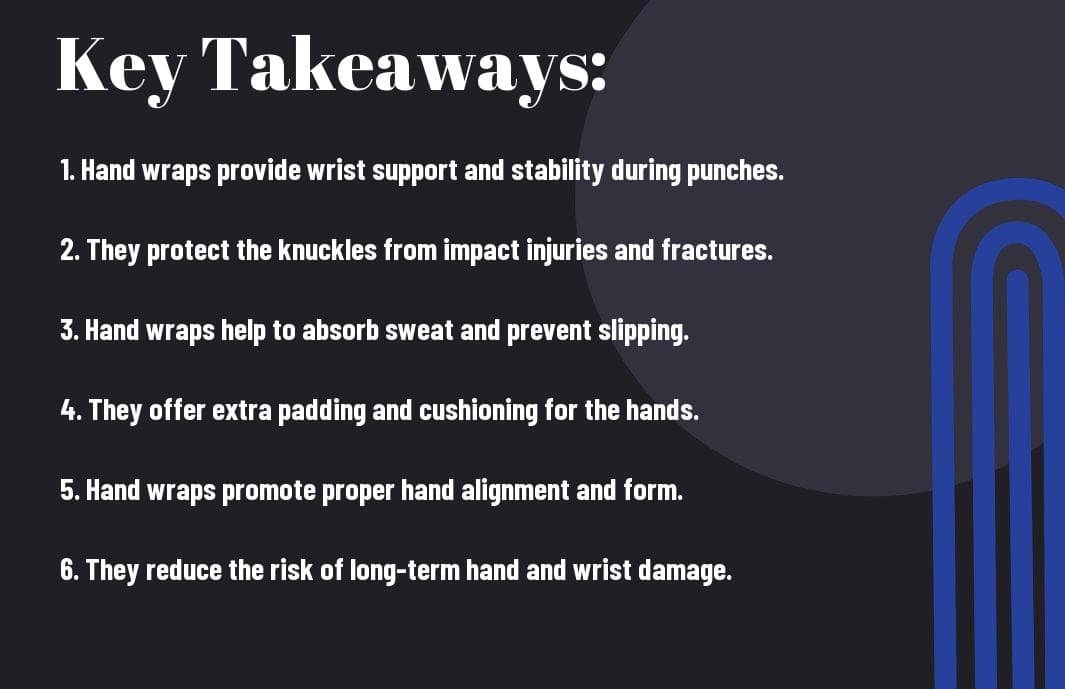Ensuring that your hands are properly protected during boxing is crucial to prevent injury and long-term damage. This is where hand wraps come into play. Whether you’re a professional or simply enjoy boxing as a hobby, wearing hand wraps not only provides support for your wrists and knuckles but also helps to reduce the risk of fractures and dislocations. In this blog post, we will delve into the significance of hand wraps in boxing and how they can protect you during training and in the ring.
Key Takeaways:
- Protection: Hand wraps provide essential support and protection to the bones, joints, and muscles in the hands and wrists during boxing practice and matches.
- Prevention of injuries: By stabilising the hand and wrist, hand wraps help to prevent injuries such as sprains, fractures, and dislocations.
- Improved performance: Well-wrapped hands can enhance a boxer’s punching technique and power by providing a solid base and reducing the risk of hand and wrist fatigue.
- Hygiene: Hand wraps act as a barrier between the skin and the boxing gloves, reducing the buildup of sweat and bacteria and helping to keep the hands clean and healthy.
- Regulation compliance: Many boxing organisations require the use of hand wraps to meet safety standards and ensure fair competition among fighters.

Understanding Hand Wraps
In boxing, hand wraps are an essential piece of equipment that provides support and protection to your hands and wrists during training and fights. They are long strips of cloth that are wrapped securely around your hands, knuckles, and wrists. Hand wraps help to stabilize your wrist and hand, reducing the risk of injury from impact and repetitive stress. For a more detailed explanation, you can refer to Hand wrap on Wikipedia.
Types of Hand Wraps for Boxing
When it comes to hand wraps for boxing, there are various types available, each offering different levels of protection and support. The most common types include cotton wraps, gel wraps, and Mexican-style wraps. Cotton wraps are traditional and provide good support, while gel wraps offer extra cushioning for your knuckles. Mexican-style wraps are longer and provide more coverage for your wrists and knuckles, offering maximum protection. Recognizing the right type of hand wrap for your needs is crucial. Below is a simple breakdown of the parameters you need to consider to recognise which type will suit your style.
| Type | Description |
|---|---|
| Cotton wraps | Traditional and good support for your hands and wrists. |
| Gel wraps | Extra cushioning for added knuckle protection. |
| Mexican-style wraps | Longer and provides maximum protection for wrists and knuckles. |
Correct Method for Wrapping Hands
Properly wrapping your hands is as crucial as using the right type of hand wraps. The correct method ensures that your hands and wrists are secured and supported for impact. When wrapping your hands, make sure to start with the loop around your thumb and gradually cover your knuckles and wrists in a figure-eight pattern. This method provides maximum stability and protection during your boxing sessions. Make sure to complete the process by securing the wrap with a hook-and-loop fastener. Using the correct method for wrapping your hands not only reduces the risk of injury but also enhances your performance in the ring.
The Benefits of Wearing Hand Wraps
When it comes to boxing, wearing hand wraps is essential for several reasons. Not only do they provide support and protection, but they can also enhance your overall performance and prevent injuries. Let’s take a closer look at the benefits of wearing hand wraps.
Shock Absorption and Distribution
One of the key benefits of wearing hand wraps is the shock absorption and distribution they provide. During boxing, your hands and wrists are subjected to powerful impacts and repetitive stress. Without proper protection, this can lead to serious injuries such as fractures or sprains. Hand wraps act as a buffer, absorbing and distributing the impact of punches across your hands, wrists, and forearms. This not only reduces the risk of injury but also allows you to punch with greater confidence and power.
Support for Bones and Joints
Another important benefit of hand wraps is the support they offer for your bones and joints. The repetitive motions and impact involved in boxing can put immense strain on your hands, wrists, and knuckles. Without adequate support, this can result in long-term damage, such as arthritis or chronic pain. By wearing hand wraps, you provide crucial support to these vulnerable areas, reducing the risk of injury and ensuring that your bones and joints remain strong and healthy.
Common Injuries and the Protection Hand Wraps Offer
When it comes to boxing, hand wraps are an essential piece of protective equipment. The hand wraps provide crucial support and protection for your hands and wrists when throwing punches and absorbing impact. Without the use of hand wraps, you are putting yourself at a greater risk of sustaining common boxing injuries. Let’s explore how hand wraps offer protection from these potential injuries.
The Risk of Knuckle Injuries
When you throw a punch in boxing, your knuckles are exposed to significant impact, which can lead to bruising, cuts, and even more serious injuries such as boxer’s fractures. Without the proper support, your knuckles are vulnerable to damage, which can result in long-term consequences for your boxing career. Hand wraps provide a layer of padding and stability that can significantly reduce the risk of knuckle injuries, allowing you to punch with confidence and power.
Prevention of Wrist Sprains and Fractures
Another common injury in boxing is wrist sprains and fractures, which can occur when the wrist is forced into unnatural positions upon impact. Without the support of hand wraps, the delicate bones and ligaments in your wrist are at a heightened risk of injury. By securing your wrists with hand wraps, you are providing essential stability and reinforcement, reducing the likelihood of sprains and fractures. This added protection allows you to throw powerful punches without compromising the integrity of your wrist.
Hand Wraps and Boxing Performance
When it comes to boxing, hand wraps are an essential piece of equipment that directly impacts your performance in the ring. Whether you are training or competing, the proper use of hand wraps can make a significant difference in your overall boxing performance.
Impact on Punching Technique and Power
One of the most critical aspects of boxing is your punching technique and power. Properly wrapped hands provide crucial support to your wrist and knuckles, allowing you to maintain the correct form when throwing punches. This significantly reduces the risk of injury and ensures that your punches are delivered with maximum impact. Without hand wraps, you are more likely to strain or even break your hand, which can severely hinder your ability to throw effective punches.
Importance for Training and Sparring Sessions
During training and sparring sessions, hand wraps are vital for protecting your hands from the constant impact of hitting heavy bags or sparring with opponents. The repetitive motion of punching can cause significant wear and tear on your hands, leading to injuries such as fractures or sprains. By using hand wraps, you provide an additional layer of support and cushioning, reducing the risk of injury and allowing you to train and spar more effectively. Additionally, hand wraps help to keep your wrist aligned and stable, enabling you to focus on improving your technique and skills without the fear of discomfort or injury.
Maintenance and Hygiene of Hand Wraps
When it comes to boxing, the importance of maintaining clean and hygienic hand wraps cannot be overstated. Not only does proper maintenance ensure the longevity of your hand wraps, but it also prevents the buildup of bacteria and odour that can lead to skin infections. In this chapter, we will explore the key aspects of hand wrap maintenance and hygiene that you need to know to keep your gear in top condition.
Cleaning and Care Instructions
Regular cleaning of your hand wraps is essential to prevent the accumulation of sweat, dirt, and bacteria. After each training session, you should untie your hand wraps and thoroughly wash them by hand using mild detergent and cold water. Avoid using hot water, as this can cause shrinkage in the fabric. Once washed, you should allow your hand wraps to air dry completely before storing them. Additionally, it is recommended to wash your hand wraps in a mesh laundry bag to prevent tangling with other items in the washing machine.
Lifespan and Replacement Frequency
The lifespan of hand wraps can vary depending on the frequency of use and the intensity of your training. As a general rule of thumb, you should replace your hand wraps every 3 to 6 months, or sooner if you notice significant wear and tear. Over time, the fabric of hand wraps can become stretched, lose elasticity, and accumulate odour-causing bacteria that cannot be fully removed through washing. Regularly inspect your hand wraps for signs of fraying, thinning, or unpleasant odours, as these are indicators that it’s time for a replacement.
Importance of Hand Wraps in Boxing
Presently, you can understand just how crucial it is to always use hand wraps when you are engaged in boxing. Your hands and wrists are extremely susceptible to injury during training or competition, and without the support and protection that hand wraps provide, you are putting yourself at a higher risk of getting hurt. As a boxer, it is your responsibility to take care of your hands and prevent unnecessary injuries, and hand wraps play a vital role in doing so. By properly wrapping your hands, you are not only safeguarding yourself from potential harm, but also maximising the stability and support of your punches, ultimately enhancing your performance and endurance in the ring. Make it a non-negotiable habit to always wrap your hands before training or fighting, as it could make all the difference in ensuring your long-term success and health in the sport.
FAQ
Q: Why are hand wraps important in boxing?
A: Hand wraps provide support and protection for the wrists, knuckles, and thumb, reducing the risk of injury during training and sparring sessions.
Q: How do hand wraps protect the hands during boxing?
A: Hand wraps help to stabilize the bones and tendons in the hand, absorbing the impact of punches and minimizing the risk of fractures or sprains.
Q: Can I train without hand wraps?
A: It is not recommended to train without hand wraps, as the repeated impact of punching heavy bags or opponents can lead to long-term hand and wrist injuries.
Q: What type of hand wraps should I use for boxing?
A: Traditional cotton hand wraps are commonly used in boxing for their flexibility and breathability, providing adequate support for the hands and wrists.
Q: How do I properly wrap my hands for boxing?
A: Start by securing the wrist, then wrap around the palm and knuckles, and finally secure the thumb. Make sure the wraps are snug but not too tight, allowing for proper blood circulation.
Q: How often should I replace my hand wraps?
A: Hand wraps should be replaced regularly, especially if they show signs of wear and tear. It is recommended to replace them every 6 months if used regularly.
Q: Are hand wraps necessary for professional boxing matches?
A: Yes, hand wraps are mandatory for professional boxing matches to ensure the safety and protection of the boxers’ hands and wrists.



